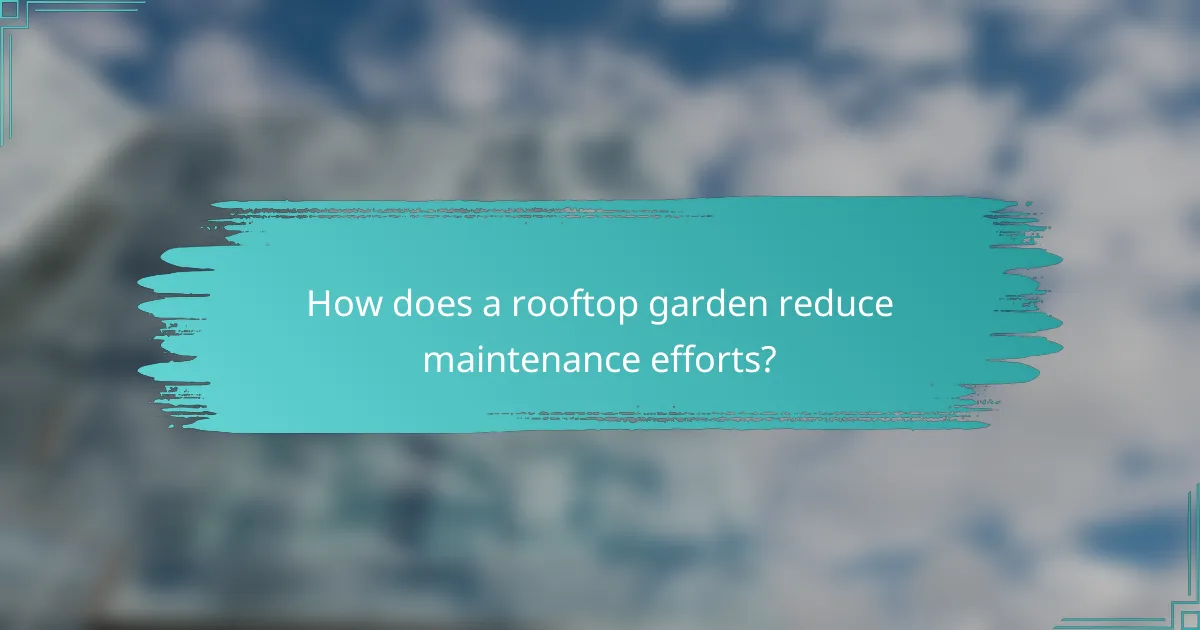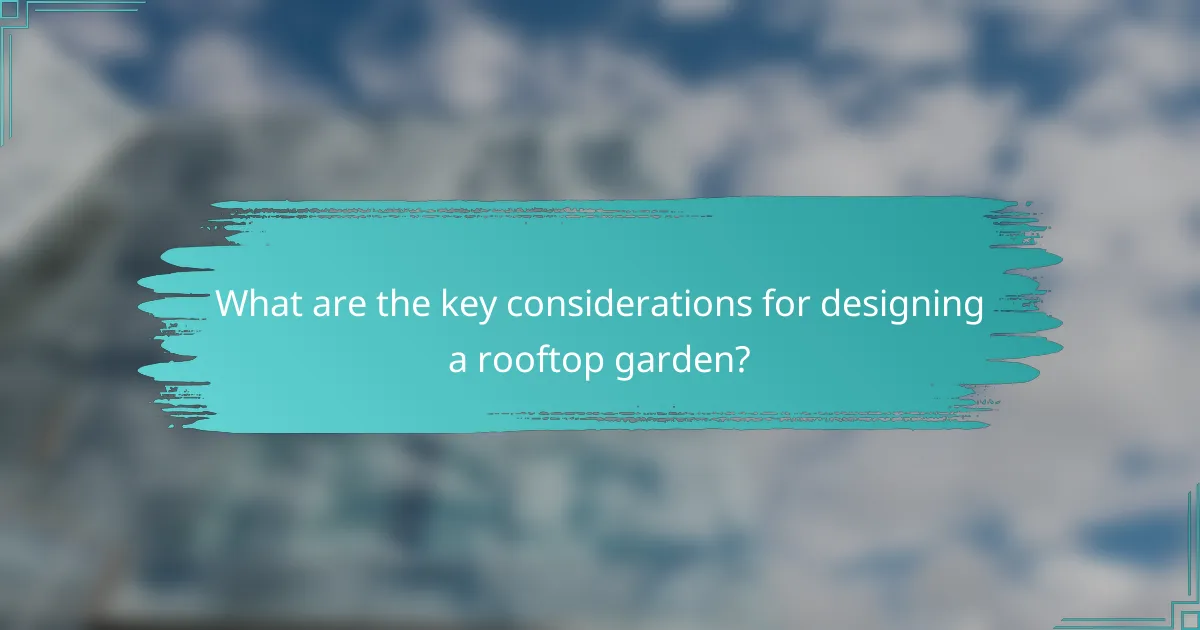Rooftop gardens play a crucial role in enhancing urban biodiversity by creating habitats for various species and supporting local ecosystems. By incorporating native, drought-resistant plants, these green spaces not only thrive in challenging conditions but also require less maintenance, making them a sustainable choice for urban environments. This thoughtful design reduces upkeep while promoting ecological balance and providing refuge for wildlife.

How can rooftop gardens enhance biodiversity in urban areas?
Rooftop gardens can significantly enhance biodiversity in urban settings by providing habitats for various species and supporting local ecosystems. These green spaces help mitigate the effects of urbanization, offering refuge for wildlife and promoting ecological balance.
Native plant species support local wildlife
Incorporating native plant species in rooftop gardens is crucial for supporting local wildlife. These plants are adapted to the local climate and soil conditions, making them more resilient and easier to maintain. They provide food and shelter for birds, insects, and other wildlife, fostering a thriving ecosystem.
Examples of native plants include wildflowers, grasses, and shrubs that are indigenous to the area. By selecting plants that naturally occur in the region, rooftop gardens can attract a diverse range of species, enhancing the overall biodiversity of urban environments.
Improved pollinator habitats
Rooftop gardens can create essential habitats for pollinators such as bees, butterflies, and hummingbirds. These gardens offer a safe space for these species to forage and reproduce, which is vital for maintaining healthy plant populations. The presence of diverse flowering plants can significantly increase the availability of nectar and pollen.
To maximize the benefits for pollinators, consider planting a variety of species that bloom at different times throughout the growing season. This ensures a continuous food source and encourages a stable pollinator population in urban areas.
Soil health and ecosystem balance
Healthy soil is foundational for a thriving rooftop garden and contributes to overall ecosystem balance. By using organic materials and compost, gardeners can improve soil structure, fertility, and moisture retention, which supports plant growth and biodiversity. Healthy soil also promotes beneficial microorganisms that play a role in nutrient cycling.
Regular maintenance practices, such as mulching and crop rotation, can further enhance soil health. Avoiding synthetic fertilizers and pesticides will help maintain a balanced ecosystem, allowing native plants and wildlife to flourish without harmful chemicals.

What native plants are best for rooftop gardens in North America?
For rooftop gardens in North America, native plants that are drought-resistant and adaptable to varying conditions are ideal. These plants not only thrive in limited soil and water but also support local biodiversity and require less maintenance.
Wildflowers like Echinacea and Rudbeckia
Wildflowers such as Echinacea (coneflower) and Rudbeckia (black-eyed Susan) are excellent choices for rooftop gardens. They are hardy, attract pollinators, and can tolerate dry conditions, making them suitable for elevated environments.
When planting these wildflowers, consider grouping them in clusters to create a visually appealing display and enhance their pollinator-friendly attributes. They typically bloom from mid-summer to fall, providing vibrant color and interest throughout the growing season.
Grasses such as Schizachyrium and Panicum
Grasses like Schizachyrium (little bluestem) and Panicum (switchgrass) are beneficial for rooftop gardens due to their deep root systems and drought tolerance. These native grasses can help stabilize soil and reduce erosion, which is crucial in a rooftop setting.
Incorporating these grasses can create a naturalistic look while providing habitat for wildlife. They thrive in full sun and can withstand varying soil types, making them versatile options for urban gardens.
Shrubs like Vaccinium and Ilex
Shrubs such as Vaccinium (blueberry) and Ilex (holly) can add structure and greenery to rooftop gardens. These shrubs are not only visually appealing but also provide edible fruits and berries, enhancing the garden’s productivity.
When selecting shrubs, ensure they are suited for the rooftop’s microclimate. Consider their mature size and spacing to avoid overcrowding, which can lead to maintenance challenges. Regular pruning can help maintain their shape and health, keeping the rooftop garden vibrant and manageable.

How does a rooftop garden reduce maintenance efforts?
A rooftop garden reduces maintenance efforts by utilizing plants that require less care and designing the space for efficiency. This approach minimizes the need for frequent watering, replanting, and labor-intensive upkeep, making it easier to maintain a thriving green space.
Low-water native plants require less irrigation
Native plants are well-adapted to local climates and soil conditions, which means they typically require less water than non-native species. By selecting drought-resistant varieties, rooftop gardens can thrive with minimal irrigation, reducing water usage and maintenance time.
For instance, in regions with hot summers, incorporating plants like sedums or native grasses can significantly lower irrigation needs. This not only conserves water but also lessens the frequency of watering tasks, allowing for a more sustainable garden.
Perennial plants minimize replanting needs
Using perennial plants in rooftop gardens minimizes the need for replanting each season, as these plants return year after year. This reduces labor and costs associated with annual planting, making maintenance more manageable.
Choosing a mix of perennials that bloom at different times can enhance visual interest while ensuring that the garden remains vibrant without the need for constant replanting. This strategy can save both time and money over the long term.
Efficient design reduces labor costs
An efficient design for a rooftop garden can significantly lower labor costs by optimizing space and plant selection. Features such as raised beds, efficient drainage systems, and automated irrigation can streamline maintenance tasks.
Incorporating modular planting systems can also simplify access for maintenance and reduce the time spent on upkeep. By planning the layout thoughtfully, garden owners can create a beautiful space that requires less ongoing effort and expense.

What are the key considerations for designing a rooftop garden?
Designing a rooftop garden requires careful attention to several critical factors, including weight load, sunlight exposure, and accessibility for maintenance. These elements ensure the garden thrives while maintaining the structural integrity of the building.
Weight load and structural integrity
Weight load is a primary concern when creating a rooftop garden. The combined weight of soil, plants, and water can be substantial, so it’s essential to assess the building’s structural capacity before installation. Consulting with a structural engineer can help determine the maximum load the roof can safely support.
To mitigate weight issues, consider using lightweight soil alternatives or modular planting systems. These options can significantly reduce the overall weight while still providing a healthy environment for plant growth.
Sunlight exposure and microclimates
Sunlight exposure is crucial for plant health in a rooftop garden. Assess the orientation of the roof and identify areas that receive full sun, partial shade, or full shade throughout the day. This information will guide plant selection and placement to ensure optimal growth.
Additionally, microclimates can develop on rooftops due to factors like wind patterns and heat retention. Understanding these variations can help you choose plants that thrive in specific conditions, enhancing biodiversity and garden resilience.
Accessibility for maintenance
Accessibility is vital for the ongoing maintenance of a rooftop garden. Ensure that pathways and access points are designed to facilitate easy movement for gardeners and maintenance personnel. This includes considering the placement of plants and structures to avoid overcrowding.
Regular maintenance tasks such as watering, pruning, and harvesting should be easily manageable. Incorporating features like irrigation systems or raised beds can further simplify upkeep and encourage a thriving garden environment.

How do rooftop gardens contribute to urban heat island mitigation?
Rooftop gardens play a significant role in mitigating urban heat island effects by cooling the surrounding air and reducing heat absorption in buildings. These gardens enhance biodiversity while promoting energy efficiency in urban areas.
Vegetation cools surrounding air
Plants in rooftop gardens absorb sunlight and release moisture through a process called transpiration, which cools the air around them. This natural cooling effect can lower local temperatures by several degrees, helping to combat the heat generated by urban infrastructure.
In densely populated cities, the presence of vegetation can significantly improve air quality and reduce the need for air conditioning, leading to lower energy consumption during hot months.
Reduction of heat absorption by buildings
Rooftop gardens can effectively reduce the amount of heat absorbed by building materials, such as concrete and asphalt, which typically retain heat. By covering these surfaces with vegetation, the overall thermal mass of the building is decreased.
This reduction in heat absorption can lead to lower indoor temperatures, which can decrease reliance on cooling systems and lower energy bills, especially during peak summer months.
Increased shading for lower energy costs
The foliage of rooftop gardens provides shade to the building below, further decreasing heat gain. This shading effect can reduce the temperature of the roof surface by a significant margin, which translates to lower cooling costs.
Incorporating native plants that thrive in the local climate can enhance this effect, as they require less water and maintenance, making rooftop gardens both cost-effective and environmentally friendly.

What are the costs associated with installing a rooftop garden?
The costs of installing a rooftop garden can vary significantly based on factors like size, materials, and plant selection. Generally, you can expect initial setup costs to range from a few hundred to several thousand dollars, depending on your design and plant choices.
Initial setup costs for materials and plants
Initial setup costs for a rooftop garden typically include expenses for soil, drainage systems, plants, and structural modifications. For a basic garden, materials might range from $10 to $30 per square foot, while more elaborate designs can exceed $50 per square foot.
When selecting plants, native species are often more cost-effective as they require less maintenance and irrigation. Budgeting for plants can range from $5 to $20 each, depending on the type and size.
Consider additional costs for installation labor, which can vary widely. Hiring professionals may add $50 to $150 per hour, while DIY projects can save money but require time and effort. Always factor in potential ongoing maintenance costs when planning your budget.
